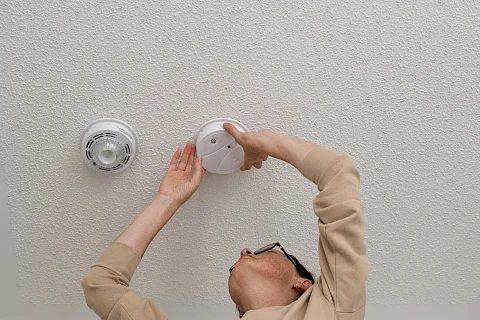
As the days grow colder, many seniors spend more time indoors, relying on heating devices to stay warm. While winter offers a cozy escape, it also presents fire hazards and risks of carbon monoxide (CO) poisoning. During these months, ensuring a safe home environment is crucial for seniors' well-being. Learn how to protect yourself and your loved ones by understanding the risks and preparing adequately.
Fire and CO Risks
The risk of home fires increases during winter. Common sources include space heaters, fireplaces, and overloaded electrical outlets. These fires can start unexpectedly and spread quickly, especially if textiles or holiday decorations are nearby.
Carbon monoxide poisoning is a silent winter danger. CO is a colorless, odorless gas that can be deadly. It often comes from malfunctioning fuel-burning appliances, like stoves, furnaces, and generators. Symptoms of CO poisoning include headaches, dizziness, and confusion.
Safe Use and Maintenance of Heating Equipment
Understanding the types of heating equipment in your home is the first step to safe use. Space heaters, gas furnaces, and fireplaces each have their risks. Space heaters can overheat and cause fires if left too close to flammable materials. Make sure they have automatic shut-off features, and always place them on a flat, sturdy surface.
A professional should inspect gas furnaces annually to prevent leaks or malfunctions. Fireplaces should be fitted with screens to prevent embers from escaping. Remember to clean chimneys yearly to avoid creosote buildup, which can ignite fires.
Regular maintenance and inspections are key. Don't neglect this step, as it ensures all your equipment functions correctly and safely.
Installing and Testing Detectors
Smoke and carbon monoxide detectors are your first defense against fires and CO poisoning. They should be installed on every level of the home and outside sleeping areas. For proper installation, follow the manufacturer's instructions or seek professional help.
Test detectors regularly, at least once a month, to ensure they are operational. Change the batteries twice yearly, even if no warnings are sounded. Consider devices with a built-in ten-year battery to reduce the need for frequent changes.
Developing an Emergency Plan
An emergency plan is crucial for both fire and CO incidents. Start by creating a fire escape plan. Identify at least two exit routes from each room and establish a meeting place outside the home. Review this plan with all family members or caregivers and ensure everyone knows how to execute it.
For CO emergencies, ensure that everyone understands the symptoms of poisoning. If the CO detector alarms, leave the home immediately and call emergency services. Avoid re-entering until professionals declare it safe.
Regular drills are essential. Practice your fire escape and CO emergency plans routinely to ensure everyone can react quickly and correctly.
Protect Seniors from Fire and Carbon Monoxide Risks
Staying safe during the winter months involves understanding potential risks and taking action. By being proactive, you can protect yourself and your loved ones from the danger of fires and CO poisoning.
Senior Helpers prioritize seniors' safety by ensuring their homes are equipped to prevent fire and carbon monoxide hazards during the winter months. Our caregivers can assist with tasks like checking smoke and carbon monoxide detectors, safely managing space heaters, and monitoring fireplaces or stoves to reduce risks. By addressing these safety concerns, we help seniors enjoy a warm and secure home environment throughout the season. Don't hesitate to contact Senior Helpers South Valley for personalized assistance or more information. Our team serves seniors in Encino, Tarzana, Sherman Oaks, Van Nuys, and Lake Balboa, offering a high standard of in-home care that can improve seniors' quality of life and keep them safe, even during this more dangerous time of year.